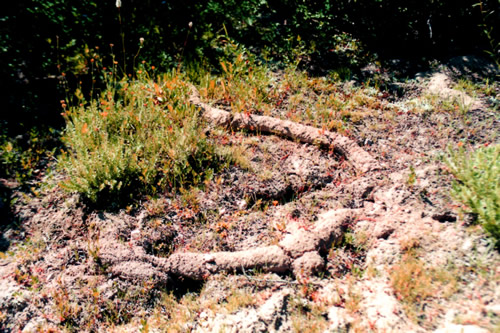
Coils of dirt left by the northern pocket gopher
Mysterious dirt coils in high mountain meadows
by Larry Hyslop

Coils of dirt left by the northern pocket gopher
Perhaps you have seen these coils, strewn about an alpine meadow high in the Ruby Mountains. They look like ropes of dirt about three inches across, snaking across the damp soil like fire hoses littering a fire scene. These mounds cross over rocks and occasionally circle around and cross themselves. I kicked apart the first one I saw, expecting it to be hollow like a hose, but they are solid coils of dirt.
They are especially noticeable in spring, as snow melts off the meadows and before vegetation grows enough to conceal them. It is surprising how steep the ground can be holding these mounds. They literally cover some meadows in the Rubies.
A northern pocket gopher looks something like a mole. Less than a pound in weight, its six-to-nine inch long body includes a two-to-three inch tail. The thickset, almost hairless, body carries powerful shoulders and front legs that end in long claws. A short neck supports a blunt head with tiny eyes and ears. Sharp upper teeth show prominently since the lips close behind these teeth.
This is the only true gopher living near Elko. What we routinely call a gopher is actually a ground squirrel. The name pocket gopher comes from its large cheek pouches that carry food and nesting materials.
They spend 99% of their lives underground, digging tunnels. One animal’s lifetime production usually covers less than one acre. The tunnels are two to five inches wide and serve two purposes. One is dug near the surface and used for gathering food. As it encounters roots, tubers and bulbs, it simply eats them. The second tunnel is deeper, used for storage, shelter and raising young.
They like meadows with deep soil. As pocket gophers dig, they push the loosened dirt behind themselves, packing it into their tunnel. Only at night do they come to the surface to deposit excess dirt in a distinctive fan shape.
During the long alpine winters, pocket gophers do not hibernate. They continue digging tunnels but deep beneath the snow, they feel safer above ground, so they dig tunnels through the snow. Excess tunnel dirt is often moved up and packed into these tunnels through the snow.
In spring, the snow melts away, revealing the packed dirt that once filled the snow tunnels. These coils of packed dirt settle to the ground, resulting in the mysterious dirt coils.
Elko Daily Free Press, “Nature Notes”, 6/17/2011
© Gray Jay Press, Elko, NV
Return to Elko Nature Notes